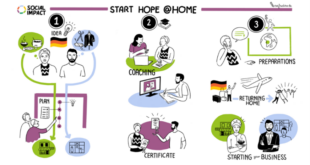More than 50,000 people have died on global migration routes since 2014, , according to a new report published by the UN’s International Organisation for Migration (IOM) on 23 November.
Despite the increasing loss of life, little action has been taken by governments in countries of origin, transit, and destination to address the ongoing global crisis of missing migrants, the report said.
“While thousands of deaths have been documented across migration routes each year, very little has been done to address the consequences of these tragedies, let alone prevent them,” says Julia Black, co-author of the report.
“Regardless of the reasons that compel or drive people to move, no one deserves to die in search of a better life.”
The nationality and origin of more than 30,000 victims are unknown, indicating that more than 60 per cent of those who die on migratory routes remain unidentified. Thus, family members of these people could usually not be notified.
Of the migrants who died and whose nationality could be determined, more than 9,000 came from African countries, over 6,500 from Asia and 3,000 from American countries, according to the IOM.
The most dangerous routes are reported to be via the Mediterranean Sea to Europe, where at least 25,104 people have died since 2014.
European routes also make up the largest total number and proportion of people who are missing and presumed dead with at least 16,032 recorded missing at sea whose remains were never recovered.
Africa is the region with the second highest number of deaths during migration. Since 2014, more than 9,000 migration deaths have been documented on the continent. In the Americas, almost 7,000 deaths have been recorded, most of them on routes to the USA (4,694).
More than 4,000 people have died at the land border between the USA and Mexico alone since 2014. The IOM, based in Geneva, is part of the United Nations and maintains a global analysis centre in Berlin. Data collection on migrant deaths began in 2014.
“We stress that obligations under international law, including the right to life, must be upheld at all times,” the IOM said. “We need to work together to prevent and reduce further deaths by prioritizing search and rescue operations, improving and expanding regular and safe migration pathways, and ensuring that migration governance prioritizes the protection and safety of people on the move.”
Sola Jolaoso
 THE AFRICAN COURIER. Reporting Africa and its Diaspora! The African Courier is an international magazine published in Germany to report on Africa and the Diaspora African experience. The first issue of the bimonthly magazine appeared on the newsstands on 15 February 1998. The African Courier is a communication forum for European-African political, economic and cultural exchanges, and a voice for Africa in Europe.
THE AFRICAN COURIER. Reporting Africa and its Diaspora! The African Courier is an international magazine published in Germany to report on Africa and the Diaspora African experience. The first issue of the bimonthly magazine appeared on the newsstands on 15 February 1998. The African Courier is a communication forum for European-African political, economic and cultural exchanges, and a voice for Africa in Europe.


























